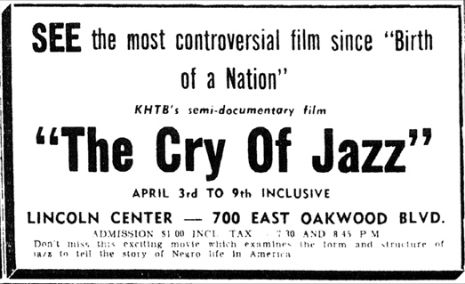Composer/arranger Edward O. Bland’s 1958 quasi-documentary short, Cry of Jazzwas one of the first films to examine Black culture. Made during the Eisenhower era when that concept hardly had a meaning to the general public, it was also perhaps the first time that assumptions of white cultural supremacy were challenged by an African-American director in cinema history.
Today the little-known film is considered a lost classic and was selected for preservation in the United States National Film Registry by the Library of Congress in 2010:
Scenes of the Arkestra were filmed at 5 or 6 club gigs between 1956 and 1958. This was before the band and its leader began wearing the distinctive Egyptian and science fiction-styled headdresses and costumes they would later become known for.“[N]ow recognized as an early and influential example of African-American independent film-making. Director Ed Bland, with the help of more than 60 volunteer crew members, intercuts scenes of life in Chicago’s black neighborhoods with interviews of interracial artists and intellectuals. “Cry of Jazz” argues that black life in America shares a structural identity with jazz music. With performance clips by the jazz composer, bandleader and pianist Sun Ra and his Arkestra, the film demonstrates the unifying tension between rehearsed and improvised jazz. “Cry of Jazz” is a historic and fascinating film that comments on racism and the appropriation of jazz by those who fail to understand its artistic and cultural origins.”
The great revolutionary poet, John Sinclair, had this to say about Cry of Jazzon his blog in 2004:
The Arkestra performances that provide the soundtrack for The Cry of Jazz underline and accent Bland’s relentlessly didactic story line and offer vivid visual contrast to the extended narrative scenes which depict a group of collegiate jazz enthusiasts heatedly engaged in a profound intellectual discussion centered on the politics of music and race and the definition, meaning and future of jazz.
Bland’s passionate, well-ordered polemic extremely advanced for the late 50s presents a systematic economic analysis of the social forces which produced and shaped the music called jazz, carefully relates them to the shape and form of the music then prevalent, and boldly forecasts what he calls the death of jazz that will be administered by a new experimental movement led by creative artists and composers (here typified by Sun Ra) who are dedicated to freeing the music from its historical strictures, reflecting the social conditions of the present, and projecting and interpreting the world of the future.
At first the story proceeds with excruciating slowness: A college jazz society meeting breaks up, leaving behind a group of stragglers a pair of white women, a white man and two black men who continue the discussion among themselves and soon reach sharp disagreement on the issues of where jazz originated, what forces shaped its development and why it sounded the way it did. Then one of the black men seizes center stage and carefully unfolds his increasingly radical analysis until his listeners are left virtually stupefied and without coherent response.
Sun Ra & the Arkestra lay down a pulsating track of sound under the narration and serve to punctuate the protagonist’s long, engrossing lecture with appropriate segments of performance footage and musical counterpoint. It’s easy to picture Sun Ra enthusiasts editing together these Arkestral appearances and eliminating the talking parts altogether, but inquisitive viewers may gain immensely from exposure to Bland’s fiercely iconoclastic exposition on the state of African American creative music on the historical cusp of the modern jazz era and the free jazz, avant garde, New Black Music movement of the 1960s.
A young Herman Poole “Sonny” Blount, before he properly understood his intergalactic roots and legally changed his name to Le Sony’r Ra
Read more:
From Sonny Blount to Sun Ra: The Chicago Years
Sounds from Tomorrow’s World: Sun Ra and the Chicago Years, 1946-1961
Purchase the DVD of Cry of Jazzat Amazon.
Saturday, January 12, 2013
CRY OF JAZZ: Only Known footage of Sun Ra and His Original Aekestra, Chicago, 1950's
from DangerousMinds:
Subscribe to:
Post Comments (Atom)


























No comments:
Post a Comment